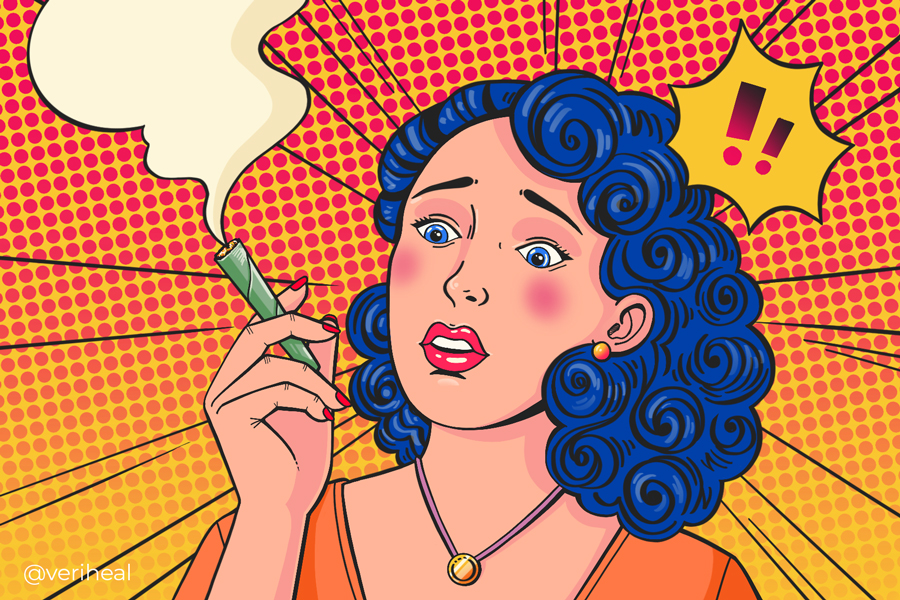Nobody wants to spend time with paranoid Pete, but if you don’t choose your cannabis strains wisely, you could get flung into a portal of paranoia yourself. Funnily enough, a recent Marist poll found that almost a third of cannabis users in the U.S. use marijuana to ease anxiety or stress. A separate Marist poll discovered that 29% of marijuana users claim that the greatest benefit of use is that cannabis reduces anxiety or stress. An additional 27% believe it helps manage medical issues.
On the other hand, anxiety, paranoia, and unpleasant thoughts are some of the most commonly reported side effects of cannabis, but why do they happen—and why do they only happen to certain people?
Marijuana use, especially heavy use (daily or almost daily) and in high doses, can result in disorientation and unpleasant thoughts or feelings of anxiety and paranoia. One journal article published in the peer-reviewed medical journal Schizophrenia Bulletin, titled “How Cannabis Causes Paranoia: Using the Intravenous Administration of ∆ 9 -Tetrahydrocannabinol (THC) to Identify Key Cognitive Mechanisms Leading to Paranoia” found that half of THC consumers reported having paranoid episodes.
Specifically, 121 participants aged 21 to 50 who had used marijuana at least once in their life and did not experience any mental issues were provided with either THC or a placebo. Based on the outcome of the investigation, 50% of THC users and 30% of placebo users reported experiencing paranoid episodes. A few key factors may trigger this in patients, so let’s dig a little deeper.
What Causes Cannabis-Related Paranoia?
Experts believe the endocannabinoid system (ECS) plays an integral role in cannabis-related paranoia. This internal biological system comprises internally produced cannabinoids (endocannabinoids) and receptors (cannabinoid receptors) that help regulate various bodily functions. When cannabis is consumed, certain compounds bind to endocannabinoid receptors scattered around multiple brain parts, including the amygdala. The amygdala helps regulate fear responses and emotions, such as anxiety, stress, and paranoia.
According to Healthline, when you consume cannabis rich in THC, your brain suddenly receives a surge of cannabinoids that may overstimulate the amygdala, thus resulting in feelings of fear and anxiety. On the other hand, a study published in the journal Psychopharmacology found that low doses of THC may produce anxiolytic effects and reduce threat-related amygdala activation.
Why You Should Get Your Medical Marijuana Card
Veriheal has satisfied millions of patients nationwide by giving them access to these benefits
- Larger purchase limits
- Peace of mind
- Enhanced legal protection
- Access to higher potency strains
- Save up to 25% on cannabis purchases
- Skip the line at the dispensary
Some cannabis users may opt for CBD—which doesn’t directly bind to endocannabinoid receptors—as a way of reducing the unpleasant side effects of THC. It’s also important to consider the terpene content of the cannabis you consume. Terpenes are molecules that give cannabis its flavor. When used in synergy with cannabinoids, they produce more intense mental effects, such as increased focus, improved mood, or reduced anxiety.
When dopamine and serotonin levels are altered in the brain, paranoia can set in. Common cannabis terpenes like myrcene and pinene may spark the onset of or help to soothe paranoia by influencing the limbic system. The limbic system is responsible for emotions and memory.
What Increases the Risk of Cannabis-Related Paranoia?
Some people face a greater chance of being engulfed with feelings of paranoia after consuming cannabis, including those who consume cannabis with a higher THC content. A 2017 study published in Science Daily and carried out at the University of Illinois at Chicago discovered that low doses of THC can potentially ease stress, whereas high doses may increase anxiety. The study, which examined 42 healthy adults, proved that 7.5 milligrams of THC was sufficient to ease the negative feelings associated with a stressful task. Increased doses of 12.5 mg triggered a spike in negative feelings.
Each person’s unique genetic composition may also affect the chances of paranoia. For example, if someone has more THC sensitivity in the back portion of their brain than the anterior, they face a higher risk of paranoia and other adverse reactions. Researchers believe that this is due to the fact that more reward-producing opioid receptors are found in the front of the brain.
A study published in Scientific Reports found evidence that psychological reactions to marijuana depend on which part of an individual’s brain is most sensitive to THC. The study was carried out at Western University in Ontario, Canada. Gender also plays a role, with one animal study from Washington State University researchers revealing that elevated estrogen levels may increase cannabis sensitivity by 30% and reduce tolerance for marijuana. Tolerance and brain chemistry may also influence feelings of post-consumption paranoia.
How to Take Control of Cannabis-Related Paranoia
Instead of tumbling from high altitudes of paranoia and into an abyss of anxiety after consuming marijuana, whether it’s by smoking, eating edibles, or vaping THC, take the reigns and steer your mindset into a blissful dimension. With the following easy tips, you can sidestep feelings of cannabis-related paranoia and make the most of your experience with the nation’s favorite herb:
- Relax – Replace paranoid thoughts with relaxing remedies. Soothe your soul with a little bit of music or art or by doing something as simple as relaxing in a comfortable chair with a good book.
- Breathing – We humans have a very valuable tool at our disposal: respiration. Take advantage of your power by practicing some deep breathing exercises.
- Nature – A little bit of vitamin D (sunshine) combined with the sights, sounds, and smells of nature will have you feeling calm in no time. Research published by the American Psychological Association indicates that interacting with nature has cognitive benefits.
Author, Share & Comments















